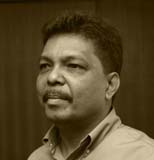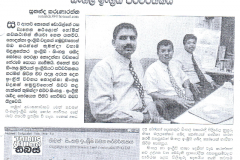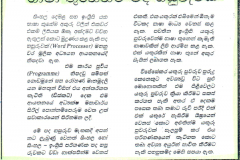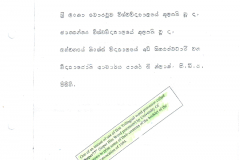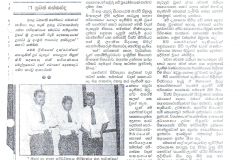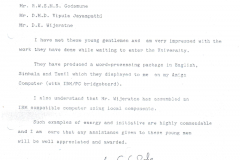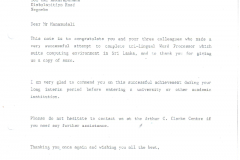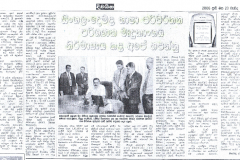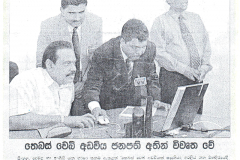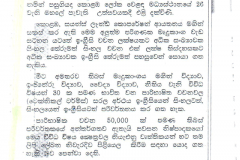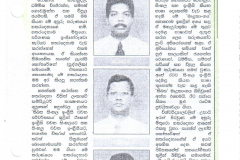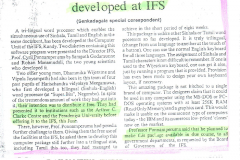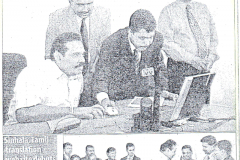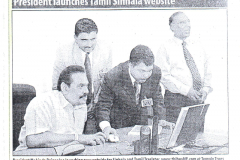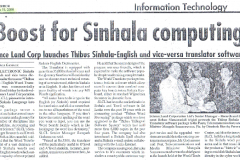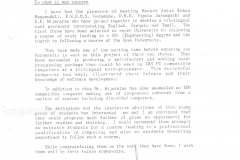Mr. Rohan Manamudali, together with Mr. Sampath Godamunne co-founded Science Land Corporation (Pvt) Ltd, in 1994 a Company solely dedicated to local language computing. Mr. Manamudali and Mr. Samapth Godamunne were co-developers tri-lingual word processor “THIBUS”, which made a huge impact on local language computing in Sri Lanka. This was a time when many people were reluctant to use computers due to not being conversant in English. Language was a huge impediment in getting people to use computers in Sri Lanka. “Thibus” filled this gap, and people were able to use word processors in Sinhala. Rohan Manamudali is a graduate of the University of Moratuwa.
Rohan Manamudali’s first introduction to computers was when as a schoolboy, he first saw the Sinclair computer at his school, Harischandra Maha Vidyalaya. In 1987, Universities were closed with no opening date in sight and Rohan could not enter the University as scheduled, in 1987. Rohan Manamudali and friends, Dhammika Wijeratne, Sampath Godamuune and later Vipula Jayampathy worked on local language computing, assembled a computer and tried to make the computer work in Sinhala, learning from books.
In 1995, Science Land developed a keyboard driver which worked on Windows and also several Sinhala and Tamil fonts. In 1997 they developed a Sinhala spell checker and a sorting system. In the year 2000, Mr. Rohan Manamudali states that they developed, what he believes was the first Sinhala electronic dictionary. This was called “Thibus word translator”. They developed Sinhala software for the local market. In 2006/2007 the team developed Sinhala text message software for mobile devices, and also Sinhala / Tamil dictionary software for mobiles.
In 2005, the Information and Communication Technology Agency (ICTA) of Sri Lanka was promoting adherence to the international standard Unicode. They therefore converted the Thibus package to be Unicode compliant.
Science Land also developed a six-way transliteration system for Sinhala, Tamil and English, for ICTA. Science Land signed another contract with ICTA, to localize the user interfaces of Windows Vista and MS Office 2007, and later to localize the user interfaces of Windows 7 and MS Office 2010. This work was carried out by a joint venture between Science Land and the University of Colombo School of Computing (UCSC). In addition, Science Land had also developed a Financial Management and Reporting System for ICTA.
Video in Brief
Full Video
Rohan Manamudali was curious about the internal workings of computers. Therefore, Rohan and his friend Dhammika Wijeratne, who had an Apple home computer tried to learn about computer architecture and microprocessors from books.
Building a security system
They thereafter tried to build a security system to detect people entering a building; they tried to interface hardware components with software and then tried to integrate infrared sensors. To do this this they collected hardware components related to IBM computers and then tried to use the components to build an IBM compatible computer. Dhammika Wijeratne was conversant in electronics and was able to assemble a computer that worked.
Getting the computer to work in Sinhala
During this period, another friend, Sampath Godamunne, who owned an Atari home computer, had been trying to get a computer to work in Sinhala. Sampath’s intention was to write letters using the computer, in Sinhala, to his fiancée. To achieve this objective, they tried to develop and IBM compatible word processor, running on DOS. During this period there were many difficulties in getting Sinhala characters to be displayed on computer screens. This team was aware of the initiatives that the Company DMS was taking in this regard. They then experimented with graphics cards and finally managed to get Sinhala characters to render properly on computer screens and even in print. At this time, the most popular word processor was WordStar. By following WordStar, they developed a Sinhala word processor through which it was possible to edit, save and print in Sinhala. This team became a foursome when another friend, Vipula jayampathy joined them.
In April 1989, the team demonstrated the Sinhala word processor to Prof. Cyril Ponnamperuma, Chairman of the Institute of Fundamental Studies (IFS) in Kandy. Prof. Ponnamperuma inquired whether Tamil could be included in the word processor.
Keyboard layout and input
The team ascertained that the Sinhala Wijesekera keyboard layout was the most popular with users, especially with users in the Government sector. This was a difficult task for them and initially the input system was such that typing the letter “A” resulted in අ and typing the Sinhala letter “B” resulted in the Sinhala letter බ. But finally, they enabled keyboard input in accordance to the Wijesekera keyboard layout. The team also took up the challenge given by Prof. Ponnamperuma on including Tamil. They first included a “phonetic” keyboard input system in the word processor and later managed to include the Renganathan input system. They had found out that the “Renganathan” keyboard layout was the most popular layout with Tamil typewriter users. Thus, in 1989, they had a tri-lingual word-processor.
In order to make the product available to others, they distributed copies of the word processor throughout the country, especially to Government organizations. They also carried out awareness programs, free of charge. Then, one day, someone handed over a copy of the word processor to Rohan, and then he knew that it was widely distributed.
Around this time, many were afraid of using computers, due to not being conversant in English. Language was a huge impediment in getting people to use computers in Sri Lanka. Thereafter, the team had visited the Sri Lanka Business Development Center, where they met Dr. Romesh Dias Bandaranaike who valued the product at Rs. 17,500/- and paid them. This is how the team started to sell the word processor. They had a partnership with DynamicRam (Pvt) Ltd, to improve the product up to a commercial level and to market it.
Thibus
They graduated from the University in 1994 and were faced with a challenge; they wondered whether to continue the work on local language computing, which they had commenced, or pursue higher studies, or else whether to seek employment. This team decided to form a Company and continue working on the area of local language computing. Dr. Romesh Dias Bandaranaike agreed to invest and consequently they formed the Company Science Land Corporation (Pvt) Ltd. This Company worked solely on local language computing. In 1995 they developed a keyboard driver which worked on Windows and also several Sinhala and Tamil fonts. In 1997 they developed a Sinhala spell checker and a sorting system. In the year 2000, Mr. Rohan Manamudali states that they developed, what he believes was the first Sinhala electronic dictionary. This was called “Thibus word translator”. They developed Sinhala software for the local market. In 2006/2007 the team developed Sinhala text message software for mobile devices, and also Sinhala dictionary software for mobiles.
In 2005, the Information and Communication Technology Agency (ICTA) of Sri Lanka was promoting adherence to the international standard Unicode. They therefore converted the Thibus package to be Unicode compliant.
Transliteration
Under another contract with ICTA, Science Land developed and implemented a six-way interoperable transliteration system for Sinhala, Tamil and English, taking into account the usage patterns and rules for handling names used in Sri Lanka. This was needed because under ICTA’s Re-engineering Government databases were being set up in Government organizations in all three languages. There was a necessity to transliterate people’s names and place names.
Localizing user interfaces
Science Land signed another contract with ICTA, to localize the user interfaces of Windows Vista and MS Office 2007, and later to localize the user interfaces of Windows 7 and MS Office 2010. This work was carried out by a joint venture between Science Land and the University of Colombo School of Computing (UCSC). ICTA, in turn had signed a contract with Microsoft Corporation.
Finally, Mr. Rohan Manamudali reminisces that it has been a long journey on local language computing, but Thibus definitely made an impact on local language users in Sri Lanka.

